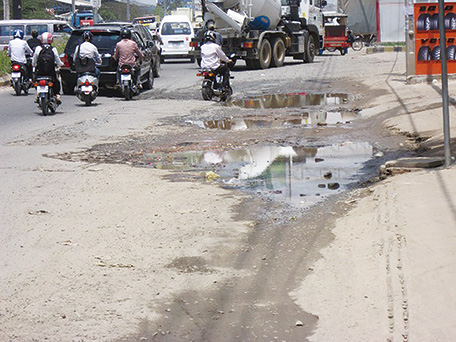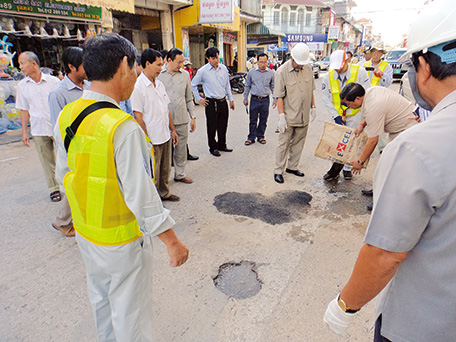Master Techniques, From Japan to the World 6
Simple Road Repair Materials that Can be Installed even during the Monsoon Season
- Proposing New Road Maintenance Management Methods in Cambodia

Large holes in the road surface cause traffic congestions and accidents. (Photo: IKEE Group)

Using the Asphalt Repairing Material (EXCEL) to repair damaged road areas. (Photo: IKEE Group)
Cambodia has been developing its road transport infrastructure since 2000 with the support of Japan and other countries. Sharply increasing traffic volumes from recent economic development and the overloading of vehicles has caused severe damage to the country’s existing roads.
Such damage will become worse if repairs are not made at the right time, not only resulting in larger budgets and longer work time, but also hindering transport safety and serving as a cause of frequent traffic accidents. Each of these issues stands in the way of Cambodia’s development.
IKEE Co., Ltd., based in Matsuyama City, Ehime Prefecture, possesses all-weather road repair and paving materials, and road maintenance technologies that can solve these development issues. IKEE’s repair materials can be installed simply by inserting them into holes in the road surface and then compacting them. This means roads can easily be repaired without the use of heavy equipment. Additionally, these materials can be used during rain when standing water is on the road. They are already widely used for road repair work throughout Japan.
Mr. Shu Nishiyama, President of IKEE Co., Ltd., hosted trainees from a construction company in Cambodia’s Battambang Province through a referral from an acquaintance involved in landmine removal in the country. Through this experience, Mr. Nishiyama learned about the current state of roads in Cambodia. As a result, he responded to a call for a Feasibility Survey1 with the Private Sector for Utilizing Japanese Technologies in ODA Projects as part of JICA’s Partnership with Japanese Small and Medium-sized Enterprises (SMEs)2 with the hope that the repair materials his company developed could be of use in Cambodia. In November 2014, the “Feasibility Survey on the Widespread Use of High Grade Asphalt Repairing Material (EXCEL) and Introduction of Pavement Management System” was launched with the participation of IKEE.
During this field study, a majority of Cambodia’s roads were found to be made from simple forms of paving, meaning that they lacked strength and that their surfaces were susceptible to potholes.
Once a pothole forms the road must be repaired immediately, but the road repair materials normally used in Cambodia mean that work takes a long time to complete. Therefore, repair work cannot take place unless the road is closed to traffic for an extended period of time. However, roads cannot be closed for long durations to industrial vehicles, which are the backbone of Cambodia’s economic development. Furthermore, Cambodia has a long monsoon season, and road repairs cannot be carried out on rainy days. This combination of factors has resulted in potholes remaining unrepaired and becoming even bigger when overloaded trucks and large buses travel over them, as well as frequent accidents caused by motorcycles and automobiles trying to avoid these potholes. This has caused constant traffic congestion.
This was exactly where IKEE’s simple road repair materials could help. Once the Feasibility Survey had been completed, Mr. Nishiyama began to prepare for the application of this technology to Cambodia.
First, Mr. Nishiyama gathered officials from Cambodia’s Ministry of Public Works and Transport and held a seminar where he introduced Japan’s road maintenance know-how, with a focus on this simple road repair material. The Vice Minister of Public Works and Transport attended the seminar, and expressed Cambodia’s strong interest and expectations.
Later, demonstrations using the simple road repair materials were carried out on major national roads around the capital of Phnom Penh and Battambang Province in Western Cambodia. With the monsoon season in mind, the road repair material was used on potholes that still had rain in them. The demonstrations confirmed that repairs could still be made in these conditions without trouble.
In this manner, road repair technologies that can be used in the heavy rains of monsoon season and that do not require heavy equipment such as road rollers were recognized by Cambodia’s Ministry of Public Works and Transport. Reviews have now commenced for the adoption of these technologies.
After the completion of the survey, Mr. Nishiyama noted, “The experience taught me that JICA projects have a great deal of credibility locally. Meeting with the Vice Minister of Public Works and Transport made work with officials from other ministries and public road companies easier. It is very difficult for a private sector company to access locally on a standalone basis, and coordinate with government ministries and stir local officials into action. I understand that JICA is planning new road and bridge projects in Cambodia. I hope to get involved in these projects and contribute to Cambodia’s development by assisting with building and maintaining roads that are safe and comfortable to travel on.”
With the goal of having Cambodia fully adopt its sophisticated yet simple road repair material, IKEE has built up a strong relationship with local companies and has now decided to set up its own company in Cambodia. Japanese paving technologies developed by a company in Ehime Prefecture will now be used to improve future road maintenance in Cambodia.
*1 A survey on the feasibility of using a certain product or technology for the development of a developing country based on a proposal from a Japanese SME.
*2 Projects that work to both develop a developing country and stimulate the Japanese economy through promoting the use of the advanced products and technologies of SMEs for the development of developing countries.
<< Previous Page
Main Text | Statistics and Reference Materials | Stories from the field | Master Techniques, From Japan to the World | ODA Topics | A Journalist’s Perspective on Japan’s ODA
